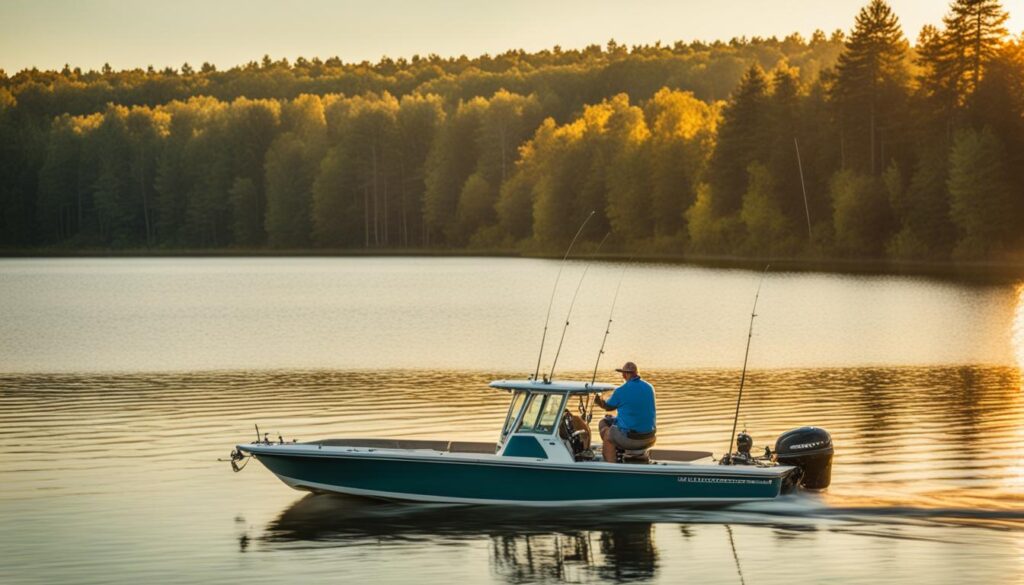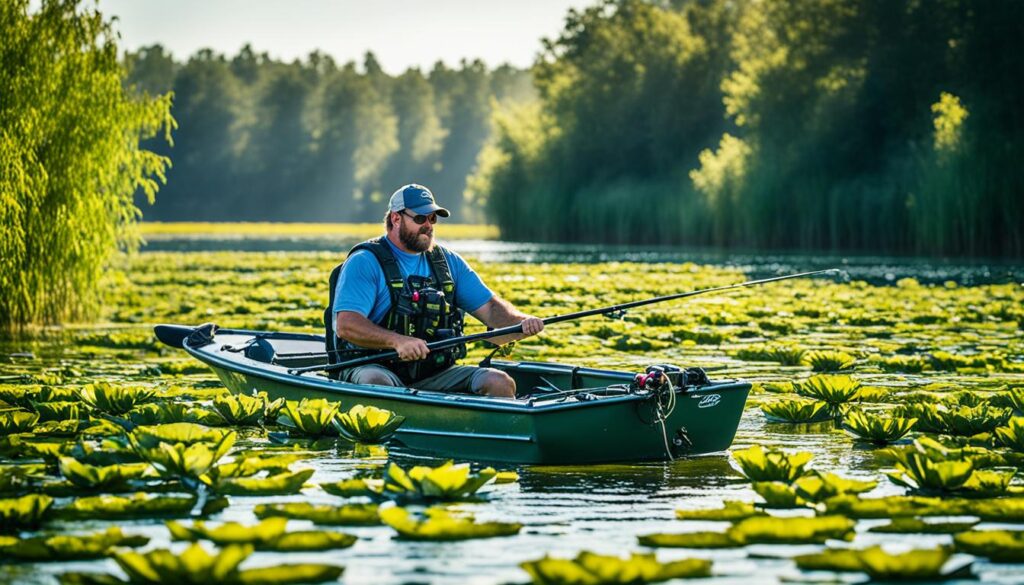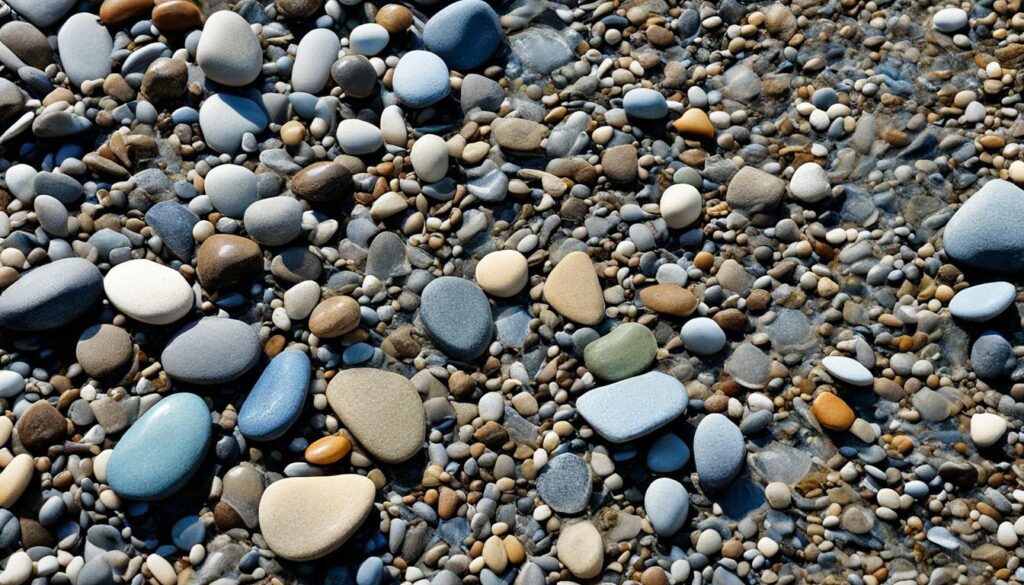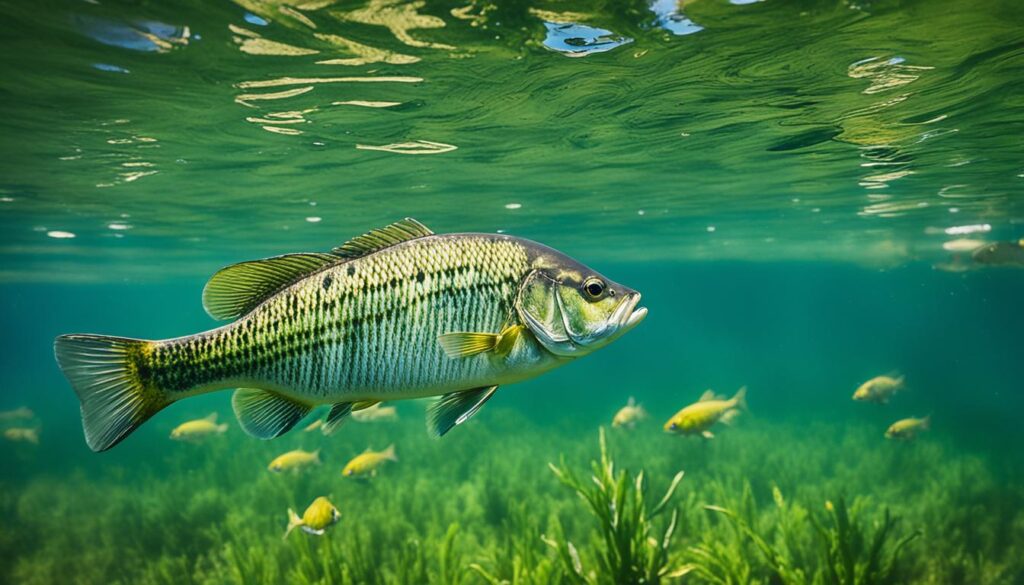Are you ready to reel in some big bass this late summer season? If you’re looking for an exciting challenge and want to increase your chances of catching trophy-sized bass, it’s time to focus on finding shallow water bass schools. By targeting these small schools of bass that gather in the shallows during late summer, you can unlock the secrets to successful bass fishing during this time of year.
In this article, I will share valuable tips and techniques for locating these elusive bass schools and the best lures to use for a successful late summer bass fishing expedition. Whether you’re a seasoned angler or new to bass fishing, this guide will equip you with the knowledge and strategies to find and catch bass in shallow water during the late summer months.
Angler’s Essentials
- Understand the behavior of bass schools in late summer
- Position your boat properly for pursuing bass schools in shallow water
- Choose the best lures for late summer bass fishing
- Recommended rod, reel, and line combos for targeting shallow water bass schools
- Overcome challenges in late summer bass fishing
Understanding Wolfpacks of Bass
During late summer, anglers can often find small schools of bass, known as wolfpacks, in shallow water. These schools consist of older and more experienced bass that have chosen to head shallow to alleviate the pressure of deep water. By grouping up in small schools, these bass exhibit hunting behavior similar to a pack of wolves, using their numbers to ambush and corral their prey.
“Wolfpacks of bass are nature’s strategic hunters. They work together to corner and attack their prey, making them a formidable force in shallow water.”
Understanding the behavior of these bass schools is crucial for anglers looking to target them in shallow water. By studying their hunting behavior and ambush tactics, anglers can increase their chances of locating and successfully catching these elusive wolfpacks.
When it comes to bass school behavior, it is important to note that small schools are more common during late summer. These schools consist of a tight-knit group of bass, typically ranging from three to eight individuals. Compared to larger schools, small bass schools tend to be more stealthy and coordinated in their hunting approach.
As these bass schools move in the shallows, they exhibit late summer bass behavior that is shaped by both their hunting instincts and the availability of prey. Shallow water bass schools are often found near areas with an abundance of food, such as spawning bluegill and bream. Anglers should focus their efforts on identifying these areas and presenting their baits in a way that mimics the natural movements of the bass’s prey.
By understanding the behavior and tactics of these wolfpacks of bass, anglers can improve their chances of success in targeting and catching these elusive and strategic predators.
Boat Positioning and Pursuit

When targeting shallow water bass schools, proper boat positioning is crucial for successful pursuit. By understanding the behavior of these schools, anglers can increase their chances of locating and targeting bass effectively. The key to boat positioning is to keep your vessel close to the shore, parallel to the bank where bass schools typically run.
Visual fishing is a valuable technique when pursuing shallow water bass. By keeping a constant eye out for signs of fish activity, such as wakes or bait skipping along the surface, you can spot the bass schools cruising in the shallows. This visual identification allows you to target specific areas where the fish are active.
Topwater bass fishing is particularly effective when pursuing bass schools in shallow water. By throwing your bait straight down the bank, you can entice the bass to strike. The commotion created by topwater lures mimics the prey that bass schools are actively feeding on, increasing your chances of enticing a bite.
Parallel Bank Fishing Technique:
- Position your boat parallel to the bank where the bass schools are running.
- Keep a constant watch for signs of fish activity such as wakes and bait skipping along the surface.
- Choose topwater lures that mimic the bass’s preferred prey and create commotion on the water’s surface.
- Throw your bait straight down the bank to target the active bass schools.
Proper boat positioning and pursuit are critical when targeting shallow water bass schools. By maintaining a close proximity to the shore, visually spotting the fish, and using topwater lures, you can maximize your chances of success. Now that you know the importance of boat positioning, let’s move on to exploring the best baits for shallow late summer bass in the next section.
Best Baits for Shallow Late Summer Bass
When targeting shallow late summer bass schools, the best baits to use are topwater lures. These lures allow you to cover more water and draw fish from greater distances.
- Poppers: Poppers are great for creating surface commotion and enticing bass to strike. These lures mimic the movements of struggling baitfish, attracting bass in the process.
- Walking Topwaters Lures: These topwater lures create a side-to-side “walk the dog” action, closely resembling the injured prey’s natural movement. Bass find this action irresistible and often strike with aggression.
- Prop-Style Baits: Prop baits, such as the River2Sea Whopper Plopper and Berkley Choppo, feature rotating blades that create a loud, splashing noise and significant disturbance on the water’s surface. This mimics the panic and commotion of fleeing baitfish, triggering feeding frenzies among bass.
Recommended Rod, Reel, and Line Combos
The right rod, reel, and line combo is crucial when fishing for shallow late-summer bass schools. I recommend using a 7-foot, 6- or 8-inch medium-heavy rod paired with a high-speed reel for larger prop baits. One good option is Lew’s Laser SG Casting Rod paired with Lew’s Classic Pro Speed Spool SLP Baitcast Reel. This combo allows long casts and easy maneuverability, especially when fishing in thick cover.
For fishing with poppers, I suggest using a 7-foot medium-heavy rod paired with a reel that has a 7:1 gear ratio. This higher gear ratio helps quickly retrieve the bait and generate the necessary commotion on the water’s surface. Using a 7:1 reel combined with a 30-pound braided line provides the strength needed for explosive strikes while also avoiding bending the small treble hooks often found on poppers.
Recommended Rod, Reel, and Line Combos:
| Technique | Rod | Reel | Line |
|---|---|---|---|
| Larger Prop Baits | 7-foot, 6- or 8-inch medium-heavy rod | Lew’s Classic Pro Speed Spool SLP Baitcast Reel | Reaction Tackle Braided Fishing Line |
| Poppers | 7-foot medium-heavy rod | Lew’s Classic Pro Speed Spool SLP Baitcast Reel | Reaction Tackle Braided Fishing Line |
Late Summer Bass Fishing Challenges

Fishing for bass in late summer can present several challenges that anglers need to overcome. These challenges include dealing with dispersed bass, pressured fish, fickle bass behavior, and a wide range of forage options that can make it difficult to entice a bite.
Dispersed Bass
During the late summer, bass tends to scatter and become more widespread throughout the water. They may move to different areas in search of food or to find more comfortable water temperatures. As a result, locating these bass can be challenging, requiring anglers to cover more water and explore various habitats.
Pressured Fish
By late summer, bass have likely experienced significant fishing pressure, causing them to become more cautious and less likely to bite. Anglers need to adjust their tactics and presentation to tempt these wary fish. Experimenting with different lures, retrieves, and even fishing during less-pressured times of the day can improve success rates.
Fickle Bass Behavior
Bass behavior can be unpredictable during the late summer months. Factors such as weather changes, water conditions, or fluctuations in forage availability can impact their feeding patterns and preferences. Anglers need to closely observe the bass’s behavior and adjust their techniques accordingly to trigger more strikes.
Wide Range of Forage
In late summer, bass have a wide range of forage options. From small baitfish to insects and crawfish, bass have plenty of food sources. This abundance of forage can make it challenging for anglers to select the right lure or bait. Experimenting with different colors, sizes, and presentations can help identify what triggers the bass’s interest.
Overcoming these challenges requires adaptability, patience, and a deep understanding of bass behavior. By staying persistent and adjusting their techniques to match the conditions, anglers can increase their chances of success in late summer bass fishing.
Late summer bass fishing presents several challenges, including dispersed bass, pressured fish, fickle bass behavior, and a wide range of forage options.
Location #1: Isolated Giants on Gravel River Bars

One effective location to find late summer bass concentrations is on isolated gravel river bars. These bars are often situated where two river channels intersect, providing bass with suitable conditions and abundant food sources. While these areas may not host large numbers of bass, they are known to produce big fish.
Locating these isolated giants can be done by using electronics to scan the break lines and identify fish arches. By carefully examining the underwater structure and paying attention to any sudden depth changes or submerged obstructions, anglers can pinpoint the most productive areas for targeting these bass.
Once the ideal location is identified, it’s time to entice bites from these isolated bass. Techniques such as strolling a football jig or using a War Eagle spoon can be effective in triggering strikes from these cautious, yet opportunistic bass.
Remember, stealth is key when fishing for isolated giants. Approach the area quietly, and avoid making unnecessary movements or creating excessive disturbances in the water. Patience, observation, and precise lure presentation are essential for success in catching these elusive trophies.
| Advantages | Considerations |
|---|---|
|
|
Location #2: Shallow Sides of Main Lake Docks
When it comes to late summer bass fishing, targeting the shallow sides of main lake docks can be highly productive. These areas often hold a significant number of quality bass, especially if you focus your efforts on the shallowest parts of the docks, such as the back posts.
Flipping and pitching techniques work well in these areas, allowing you to place your bait precisely where the bass are hiding. One effective lure for dock fishing is the Gambler Ugly Otter. Its lifelike appearance and tantalizing action can entice even the most finicky bass to bite.
When approaching main lake docks, pay close attention to depth variations. Docks in similar depth zones can help establish a productive pattern, as bass tend to gravitate towards areas that provide them with the optimal conditions for feeding and shelter.
Dock Fishing Tips:
- Target the shallowest part of the dock, such as the back posts
- Use flipping and pitching techniques to place your bait accurately
- Try the Gambler Ugly Otter for its realistic appearance and enticing action
- Pay attention to depth variations and focus on docks in similar depth zones
Location #3: Long, Flat Points
When it comes to finding late summer bass, long, flat points on highland impoundments are an excellent location to target. These points act as natural ambush points for bass, attracting scattered fish and providing ample opportunities for anglers. To maximize your success, consider using walking topwater lures like the Heddon Super Spook. The erratic, side-to-side action of these lures perfectly mimics a wounded baitfish, enticing bass to strike.
When working a long, flat point, start at the ends and work your way towards shallower areas. Pay close attention to any isolated cover such as stumps or rocks, as bass often use these as additional ambush points. Cast your lure near these structures and use a slow, steady retrieve to draw the attention of nearby bass. Be patient and persistent, as big bass are known to lurk in these prime late summer locations.
Expert Angler Tip:
For maximum effectiveness, try using a stop-and-go retrieve with your walking topwater lure. This imitates a wounded or disoriented baitfish, triggering the predatory instincts of bass and inducing aggressive strikes.
Location #4: Flats in the Backs of Major Creeks
One of the productive areas to target late summer bass is the flats in the backs of major creeks. These flats serve as transition zones for bass and can hold excellent concentrations of fish. Unlike other locations, bass make their move to these flats earlier than expected, making it an ideal spot for anglers. To effectively target bass relating to the deep water structure in this area, dropshot fishing or other vertical presentations are highly effective.
By using dropshot rigs, anglers can present their bait right above the bass suspending over the deep structure. This technique helps to entice strikes and catch the attention of these fish. However, it’s essential to keep an eye on your electronics and pinpoint fish activity. This will give you a better understanding of bass behavior and improve your chances of success in this location.
Benefits of Fishing Flats in the Backs of Major Creeks
- High concentrations of bass
- Early transition zone for bass
- Variety of deep water structure
- Targeting suspended bass
“Fishing flats in the backs of major creeks has yielded some of my best late summer bass catches. The concentration of fish and the opportunity to target suspended bass make it an exciting and productive location.” – Experienced Angler
To make the most of your time fishing flats in the backs of major creeks, it’s important to have the right gear. A sensitive rod and reel combo is crucial for detecting subtle bites and properly working your presentation. Additionally, having a variety of dropshot baits with different colors and sizes will enable you to adjust to changing conditions and bass preferences.
Conclusion
Late summer bass fishing can be a challenging yet rewarding pursuit for anglers. Utilizing the techniques and targeting the specific locations discussed in this article can greatly increase your chances of finding and catching shallow late summer bass schools. Remember that persistence is key when facing dispersed bass and pressured fish. Be adaptable in your tactics, adjusting them based on the behavior of the bass and the available forage.
Additionally, enjoy the hunt! Late summer bass fishing is not just about the end result but also about the process itself. Embrace the excitement of exploring new areas, trying different lures, and strategizing your approach. It’s the thrill of the chase that makes bass fishing in late summer so captivating.
In conclusion, equip yourself with knowledge, be persistent, adaptable, and enjoy every moment on the water. Late summer bass fishing holds immense potential for those who are willing to put in the effort and embrace the challenges. With determination and a love for the sport, you can have a successful and fulfilling fishing experience during this peak season.
FAQ
How can I find shallow late summer bass schools?
To find shallow late summer bass schools, focus on shallow water and look for small packs of bass in the shallows. These bass schools, also known as wolfpacks, can be found seeking refuge from deep water and preying on shallow spawning bluegill and bream.
What are the behavior characteristics of bass schools?
Bass schools, or wolfpacks, exhibit hunting behavior similar to a pack of wolves. They use their numbers to ambush and corral their prey. Understanding this behavior is key to locating and targeting these bass schools in shallow water.
How should I position my boat to pursue bass schools in shallow water?
Position your boat close to the shore and throw your bait straight down the bank, as the bass schools typically run parallel to the bank. Keep a constant eye out for signs of fish activity, such as wakes or bait skipping along the surface, to spot and target the bass schools effectively.
What are the best baits to use for catching shallow late summer bass schools?
Topwater lures are the best baits for targeting shallow late summer bass schools. Poppers, walking topwaters, and twin-prop baits are all effective, but prop-style baits like the River2Sea Whopper Plopper and Berkley Choppo are particularly favored for creating commotion and mimicking struggling prey.
What rod, reel, and line combo should I use for targeting shallow late summer bass schools?
For larger prop baits, use a 7-foot, 6- or 8-inch medium-heavy rod paired with a high-speed reel like the Lew’s Super Duty Speed Spool. For poppers, a 7-foot medium-heavy rod with a 7:1 reel and 30-pound braid is preferred to handle the fight with the smaller treble hooks.
What are some challenges I may face while late summer bass fishing?
Late summer bass fishing presents challenges such as dispersed bass, fish seeking different types of forage, and cautious behavior due to heavy pressure. Understanding these challenges and adjusting your tactics accordingly is essential for success.
Where can I find isolated giants of late summer bass?
Isolated gravel river bars, particularly where two river channels intersect, are prime locations to find isolated giants of late summer bass. These areas provide suitable conditions and abundant food sources, making them attractive to big fish.
What are the best locations for late summer bass fishing?
The shallow sides of main lake docks, long, flat points on highland impoundments, and flats in the backs of major creeks are all fruitful locations for late summer bass fishing. Each location requires different techniques and lures to effectively target the bass.
How should I adjust my fishing approach in flats in the backs of major creeks?
In flats in the backs of major creeks, use vertical presentations like dropshot rigs to target bass relating to deep water structures. Use your electronics to pinpoint fish activity and adjust your techniques accordingly.
What should I keep in mind when late summer bass fishing?
Persistence, adaptability, and enjoying the hunt are key elements of success during late summer bass fishing. Adjust your tactics based on bass behavior and available forage, and be prepared to cover water and try different lures until you find what works best.
